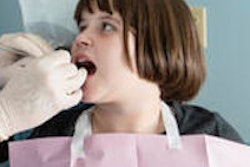
Training primary care physicians to do oral health assessments, provide preventive education, and apply fluoride varnish in very young children can ease access-to-care issues for low-income populations, according to researchers from the University of North Carolina (UNC) at Chapel Hill (Health Affairs, December 2010, Vol. 29:12, pp. 2278-2285).
At the end of the 1990s, only 16% of North Carolina dentists actively participated in Medicaid, and only one out of every 10 children younger than age 6 who were on Medicaid used any dental services, according to lead author Gary Rozier, DDS, MPH, a professor in the department of health policy and management at UNC. In addition, 40% of the state's children experienced dental caries by kindergarten.
North Carolina ranks 47th in the U.S. in dentist-to-population ratio, Dr. Rozier noted. In 2005, 32% of the state's counties had fewer than two dentists per 10,000 people, and 33 counties experienced a decline in dentist supply relative to population between 1996 and 2005.
These and related issues prompted state officials to create the Mouths of Babes program, which reimburses physicians and physician extenders for up to six preventive oral health visits for Medicaid-enrolled children younger than age 3. To be reimbursed, they must provide three services in a single visit: assess dental caries and risk, apply fluoride varnish to the kids' teeth, and counsel parents on the proper ways to care for their children's oral health.
6-year study
When the program launched in 2000, some 1,400 North Carolina medical practices with a total patient population of 240,000 Medicaid-eligible children through age 2 were eligible to participate, the researchers noted. Between 2000 and 2006, about 3,000 providers in almost 600 practices were trained to provide the oral health assessment and preventive services, and practice adoption rates were more than 60%, according to the research team.
“We are not going to drill and fill our way out of the access-to-care issue.”
— John Liu, DDS, president, American
Academy of Pediatric Dentistry
By the end of the UNC study (2006), approximately 30% of well-child visits for Medicaid children ages 6 months to 3 years in North Carolina included these services, they noted. In fact, by 2006 the rate of oral health visits in medical offices greatly exceeded the rate of dentist visits for this patient population and was almost four times the rate of dentist visits with fluoride. Depending on the age, 18% to 39% of children had one or more fluoride applications in 2006 as part of a medical visit -- a rate much higher than in dental offices. In fact, nationally, only 2.5% of children younger than age 4 with teeth had fluoride treatments from dentists in 2006, the researchers noted.
And more recent data from the North Carolina Division of Medical Assistance show that the upward trend in oral health services provided in medical offices observed in the study continued through 2009, they added.
"There is a substantial increase in access to dental services as a result of this program," Dr. Rozier said. "North Carolina went from the bottom of the list to, just a few weeks ago, becoming No. 1 in the provision of preventive care services for kids ages 1 through 8, according to CMS."
Participation by medical providers was greatest in rural areas of the state where shortages of dentists are most severe, he added.
"The fewer the number of dentists in a particular county, the higher the provision of these services in medical offices," Dr. Rozier said. Nonwhites, Hispanics, and other high-risk children were more likely to get these services in both rural and urban areas, he added.
"This is the first paper to come out that looks specifically at the effectiveness of this type of program in improving access to preventive services," Dr. Rozier said. "We have other papers coming out that look at the extent to which the services appear to reduce the need for treatment-related services."
THE solution?
John Liu, DDS, president of the American Academy of Pediatric Dentistry, believes programs such as this one are THE solution to the access-to-care issue -- especially when combined with a dental home initiative to ensure follow-up care and monitoring.
"I think it is a wonderful thing to get the pediatricians involved to ensure kids are getting preventive services at an early age because often they don't get to the dentist until too late," he told DrBicuspid.com. "This program helps pediatricians begin to realize that they need to look at what is between the lips and the back of the throat more often."
It would be even more successful if practitioners could ensure that the children end up in a dental home through a referral to a dentist in the community who can then monitor the child and family over time, and reinforce the good oral health messaging, he added.
"We are not going to drill and fill our way out of the access-to-care issue," Dr. Liu said. "The only way to deal with it is to move further upstream. We need to ensure that 1-year-olds and even pregnant women start now with good oral health habits. Right now the system pays for a filling, not for teaching a mother about oral health. We need to show good evidence that it does make a different to go further upstream. The messaging needs to be consistent and ongoing, and that's why we need physicians and even ob/gyns talking about the importance of good oral healthcare."
While North Carolina was one of the first states to offer this type of program, about 40 states now do, according to Dr. Rozier.
Copyright © 2010 DrBicuspid.com



















